Charu Sharma
Federated Spectral Graph Transformers Meet Neural Ordinary Differential Equations for Non-IID Graphs
Apr 16, 2025Abstract:Graph Neural Network (GNN) research is rapidly advancing due to GNNs' capacity to learn distributed representations from graph-structured data. However, centralizing large volumes of real-world graph data for GNN training is often impractical due to privacy concerns, regulatory restrictions, and commercial competition. Federated learning (FL), a distributed learning paradigm, offers a solution by preserving data privacy with collaborative model training. Despite progress in training huge vision and language models, federated learning for GNNs remains underexplored. To address this challenge, we present a novel method for federated learning on GNNs based on spectral GNNs equipped with neural ordinary differential equations (ODE) for better information capture, showing promising results across both homophilic and heterophilic graphs. Our approach effectively handles non-Independent and Identically Distributed (non-IID) data, while also achieving performance comparable to existing methods that only operate on IID data. It is designed to be privacy-preserving and bandwidth-optimized, making it suitable for real-world applications such as social network analysis, recommendation systems, and fraud detection, which often involve complex, non-IID, and heterophilic graph structures. Our results in the area of federated learning on non-IID heterophilic graphs demonstrate significant improvements, while also achieving better performance on homophilic graphs. This work highlights the potential of federated learning in diverse and challenging graph settings. Open-source code available on GitHub (https://github.com/SpringWiz11/Fed-GNODEFormer).
Predict Confidently, Predict Right: Abstention in Dynamic Graph Learning
Jan 14, 2025Abstract:Many real-world systems can be modeled as dynamic graphs, where nodes and edges evolve over time, requiring specialized models to capture their evolving dynamics in risk-sensitive applications effectively. Temporal graph neural networks (GNNs) are one such category of specialized models. For the first time, our approach integrates a reject option strategy within the framework of GNNs for continuous-time dynamic graphs. This allows the model to strategically abstain from making predictions when the uncertainty is high and confidence is low, thus minimizing the risk of critical misclassification and enhancing the results and reliability. We propose a coverage-based abstention prediction model to implement the reject option that maximizes prediction within a specified coverage. It improves the prediction score for link prediction and node classification tasks. Temporal GNNs deal with extremely skewed datasets for the next state prediction or node classification task. In the case of class imbalance, our method can be further tuned to provide a higher weightage to the minority class. Exhaustive experiments are presented on four datasets for dynamic link prediction and two datasets for dynamic node classification tasks. This demonstrates the effectiveness of our approach in improving the reliability and area under the curve (AUC)/ average precision (AP) scores for predictions in dynamic graph scenarios. The results highlight our model's ability to efficiently handle the trade-offs between prediction confidence and coverage, making it a dependable solution for applications requiring high precision in dynamic and uncertain environments.
Towards a Training Free Approach for 3D Scene Editing
Dec 17, 2024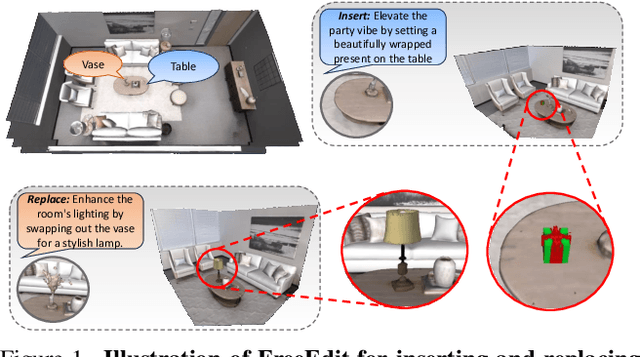
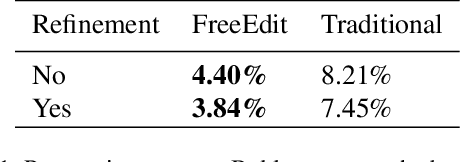
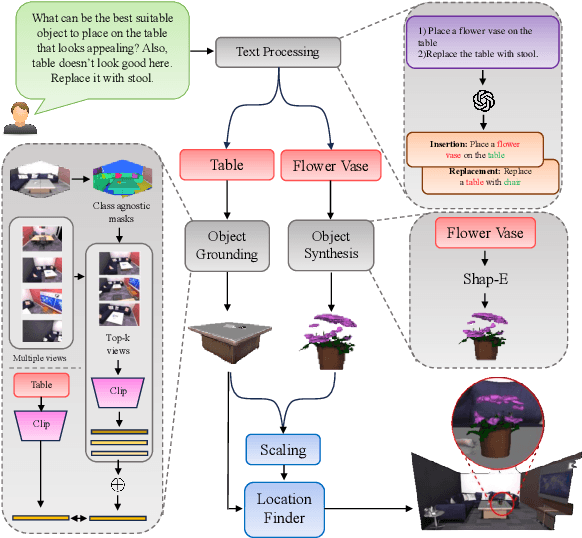

Abstract:Text driven diffusion models have shown remarkable capabilities in editing images. However, when editing 3D scenes, existing works mostly rely on training a NeRF for 3D editing. Recent NeRF editing methods leverages edit operations by deploying 2D diffusion models and project these edits into 3D space. They require strong positional priors alongside text prompt to identify the edit location. These methods are operational on small 3D scenes and are more generalized to particular scene. They require training for each specific edit and cannot be exploited in real-time edits. To address these limitations, we propose a novel method, FreeEdit, to make edits in training free manner using mesh representations as a substitute for NeRF. Training-free methods are now a possibility because of the advances in foundation model's space. We leverage these models to bring a training-free alternative and introduce solutions for insertion, replacement and deletion. We consider insertion, replacement and deletion as basic blocks for performing intricate edits with certain combinations of these operations. Given a text prompt and a 3D scene, our model is capable of identifying what object should be inserted/replaced or deleted and location where edit should be performed. We also introduce a novel algorithm as part of FreeEdit to find the optimal location on grounding object for placement. We evaluate our model by comparing it with baseline models on a wide range of scenes using quantitative and qualitative metrics and showcase the merits of our method with respect to others.
Node Classification With Integrated Reject Option
Dec 04, 2024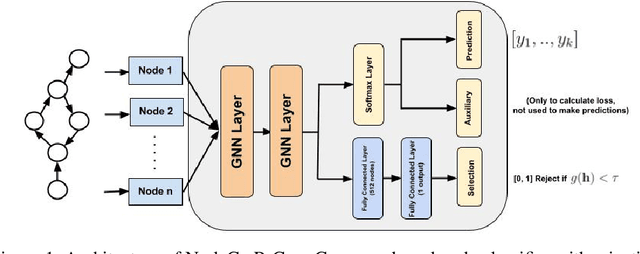
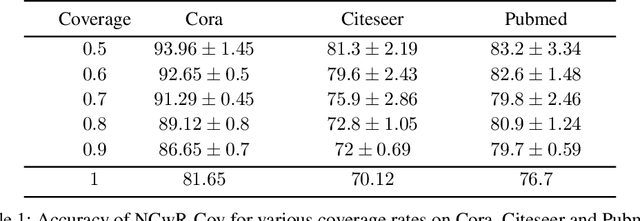
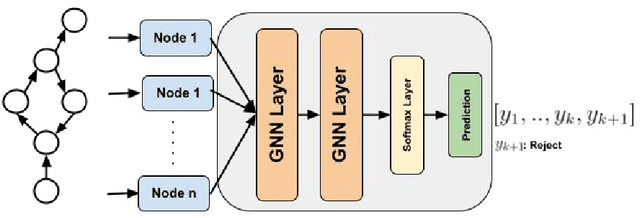

Abstract:One of the key tasks in graph learning is node classification. While Graph neural networks have been used for various applications, their adaptivity to reject option setting is not previously explored. In this paper, we propose NCwR, a novel approach to node classification in Graph Neural Networks (GNNs) with an integrated reject option, which allows the model to abstain from making predictions when uncertainty is high. We propose both cost-based and coverage-based methods for classification with abstention in node classification setting using GNNs. We perform experiments using our method on three standard citation network datasets Cora, Citeseer and Pubmed and compare with relevant baselines. We also model the Legal judgment prediction problem on ILDC dataset as a node classification problem where nodes represent legal cases and edges represent citations. We further interpret the model by analyzing the cases that the model abstains from predicting by visualizing which part of the input features influenced this decision.
GENIE: Watermarking Graph Neural Networks for Link Prediction
Jun 07, 2024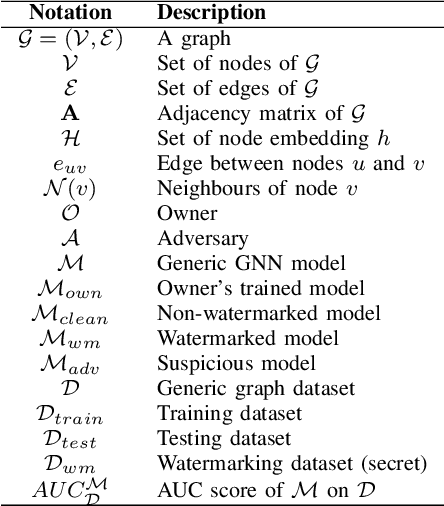
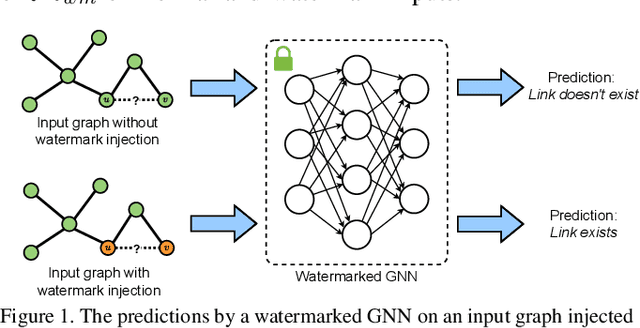

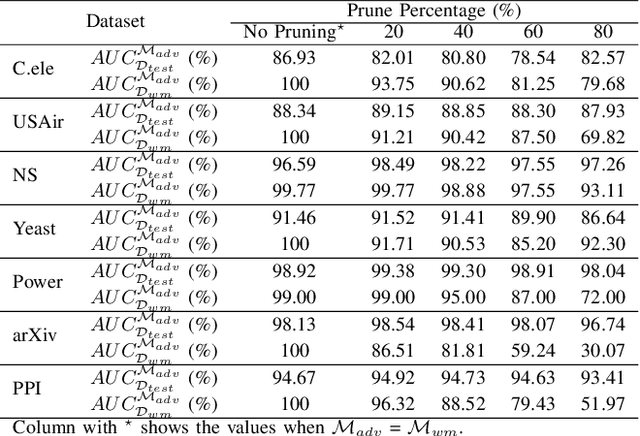
Abstract:Graph Neural Networks (GNNs) have advanced the field of machine learning by utilizing graph-structured data, which is ubiquitous in the real world. GNNs have applications in various fields, ranging from social network analysis to drug discovery. GNN training is strenuous, requiring significant computational resources and human expertise. It makes a trained GNN an indispensable Intellectual Property (IP) for its owner. Recent studies have shown GNNs to be vulnerable to model-stealing attacks, which raises concerns over IP rights protection. Watermarking has been shown to be effective at protecting the IP of a GNN model. Existing efforts to develop a watermarking scheme for GNNs have only focused on the node classification and the graph classification tasks. To the best of our knowledge, we introduce the first-ever watermarking scheme for GNNs tailored to the Link Prediction (LP) task. We call our proposed watermarking scheme GENIE (watermarking Graph nEural Networks for lInk prEdiction). We design GENIE using a novel backdoor attack to create a trigger set for two key methods of LP: (1) node representation-based and (2) subgraph-based. In GENIE, the watermark is embedded into the GNN model by training it on both the trigger set and a modified training set, resulting in a watermarked GNN model. To assess a suspect model, we verify the watermark against the trigger set. We extensively evaluate GENIE across 3 model architectures (i.e., SEAL, GCN, and GraphSAGE) and 7 real-world datasets. Furthermore, we validate the robustness of GENIE against 11 state-of-the-art watermark removal techniques and 3 model extraction attacks. We also demonstrate that GENIE is robust against ownership piracy attack. Our ownership demonstration scheme statistically guarantees both False Positive Rate (FPR) and False Negative Rate (FNR) to be less than $10^{-6}$.
Generating Explanations for Cellular Neural Networks
Jun 06, 2024Abstract:Recent advancements in graph learning contributed to explaining predictions generated by Graph Neural Networks. However, existing methodologies often fall short when applied to real-world datasets. We introduce HOGE, a framework to capture higher-order structures using cell complexes, which excel at modeling higher-order relationships. In the real world, higher-order structures are ubiquitous like in molecules or social networks, thus our work significantly enhances the practical applicability of graph explanations. HOGE produces clearer and more accurate explanations compared to prior methods. Our method can be integrated with all existing graph explainers, ensuring seamless integration into current frameworks. We evaluate on GraphXAI benchmark datasets, HOGE achieves improved or comparable performance with minimal computational overhead. Ablation studies show that the performance gain observed can be attributed to the higher-order structures that come from introducing cell complexes.
Explaining Indian Stock Market through Geometry of Scale free Networks
Apr 06, 2024
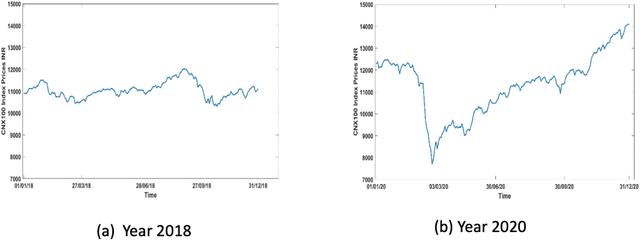

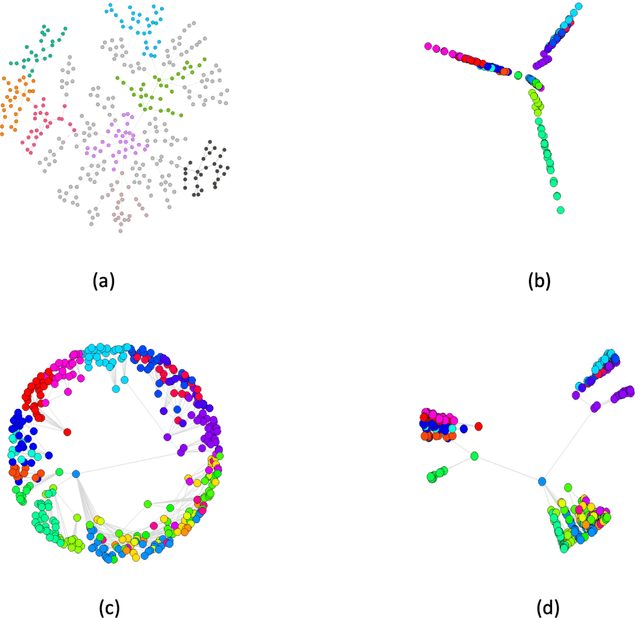
Abstract:This paper presents an analysis of the Indian stock market using a method based on embedding the network in a hyperbolic space using Machine learning techniques. We claim novelty on four counts. First, it is demonstrated that the hyperbolic clusters resemble the topological network communities more closely than the Euclidean clusters. Second, we are able to clearly distinguish between periods of market stability and volatility through a statistical analysis of hyperbolic distance and hyperbolic shortest path distance corresponding to the embedded network. Third, we demonstrate that using the modularity of the embedded network significant market changes can be spotted early. Lastly, the coalescent embedding is able to segregate the certain market sectors thereby underscoring its natural clustering ability.
Synergizing Contrastive Learning and Optimal Transport for 3D Point Cloud Domain Adaptation
Aug 27, 2023



Abstract:Recently, the fundamental problem of unsupervised domain adaptation (UDA) on 3D point clouds has been motivated by a wide variety of applications in robotics, virtual reality, and scene understanding, to name a few. The point cloud data acquisition procedures manifest themselves as significant domain discrepancies and geometric variations among both similar and dissimilar classes. The standard domain adaptation methods developed for images do not directly translate to point cloud data because of their complex geometric nature. To address this challenge, we leverage the idea of multimodality and alignment between distributions. We propose a new UDA architecture for point cloud classification that benefits from multimodal contrastive learning to get better class separation in both domains individually. Further, the use of optimal transport (OT) aims at learning source and target data distributions jointly to reduce the cross-domain shift and provide a better alignment. We conduct a comprehensive empirical study on PointDA-10 and GraspNetPC-10 and show that our method achieves state-of-the-art performance on GraspNetPC-10 (with approx 4-12% margin) and best average performance on PointDA-10. Our ablation studies and decision boundary analysis also validate the significance of our contrastive learning module and OT alignment.
GrapeQA: GRaph Augmentation and Pruning to Enhance Question-Answering
Mar 22, 2023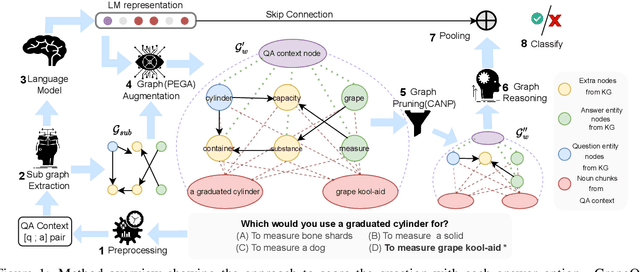
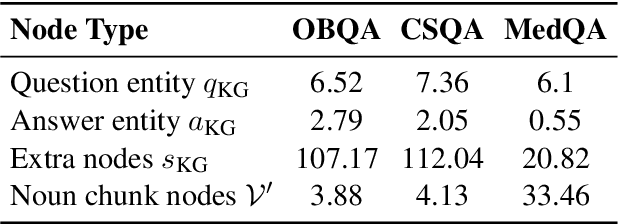
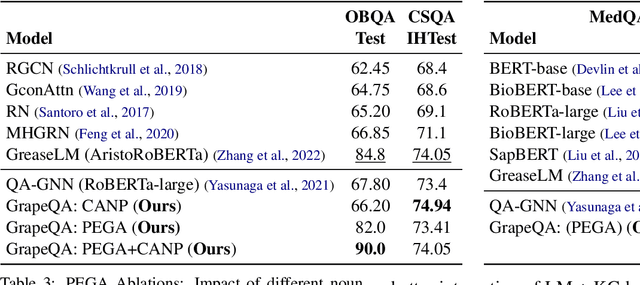
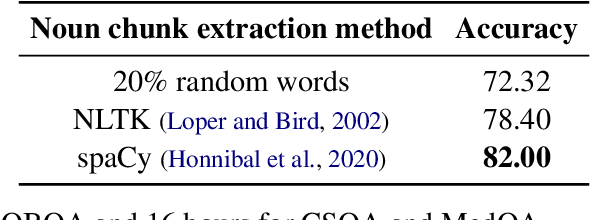
Abstract:Commonsense question-answering (QA) methods combine the power of pre-trained Language Models (LM) with the reasoning provided by Knowledge Graphs (KG). A typical approach collects nodes relevant to the QA pair from a KG to form a Working Graph (WG) followed by reasoning using Graph Neural Networks(GNNs). This faces two major challenges: (i) it is difficult to capture all the information from the QA in the WG, and (ii) the WG contains some irrelevant nodes from the KG. To address these, we propose GrapeQA with two simple improvements on the WG: (i) Prominent Entities for Graph Augmentation identifies relevant text chunks from the QA pair and augments the WG with corresponding latent representations from the LM, and (ii) Context-Aware Node Pruning removes nodes that are less relevant to the QA pair. We evaluate our results on OpenBookQA, CommonsenseQA and MedQA-USMLE and see that GrapeQA shows consistent improvements over its LM + KG predecessor (QA-GNN in particular) and large improvements on OpenBookQA.
Person Re-Identification with a Locally Aware Transformer
Jun 08, 2021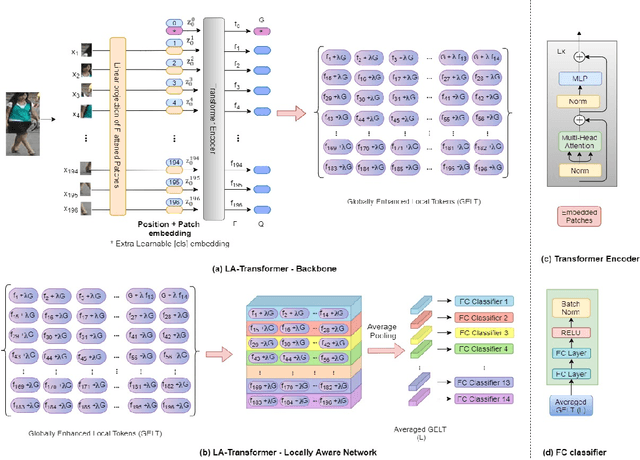


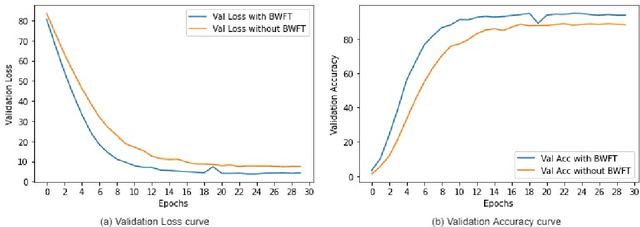
Abstract:Person Re-Identification is an important problem in computer vision-based surveillance applications, in which the same person is attempted to be identified from surveillance photographs in a variety of nearby zones. At present, the majority of Person re-ID techniques are based on Convolutional Neural Networks (CNNs), but Vision Transformers are beginning to displace pure CNNs for a variety of object recognition tasks. The primary output of a vision transformer is a global classification token, but vision transformers also yield local tokens which contain additional information about local regions of the image. Techniques to make use of these local tokens to improve classification accuracy are an active area of research. We propose a novel Locally Aware Transformer (LA-Transformer) that employs a Parts-based Convolution Baseline (PCB)-inspired strategy for aggregating globally enhanced local classification tokens into an ensemble of $\sqrt{N}$ classifiers, where $N$ is the number of patches. An additional novelty is that we incorporate blockwise fine-tuning which further improves re-ID accuracy. LA-Transformer with blockwise fine-tuning achieves rank-1 accuracy of $98.27 \%$ with standard deviation of $0.13$ on the Market-1501 and $98.7\%$ with standard deviation of $0.2$ on the CUHK03 dataset respectively, outperforming all other state-of-the-art published methods at the time of writing.
 Add to Chrome
Add to Chrome Add to Firefox
Add to Firefox Add to Edge
Add to Edge